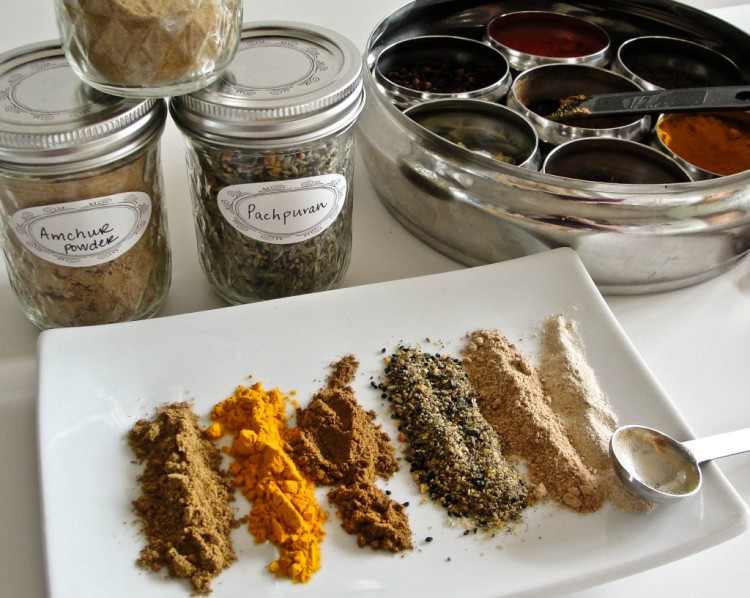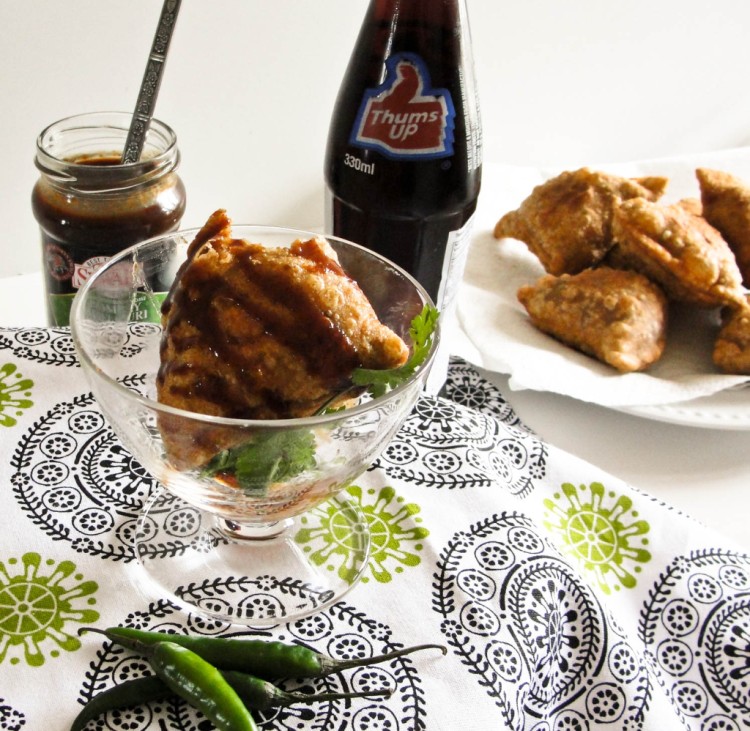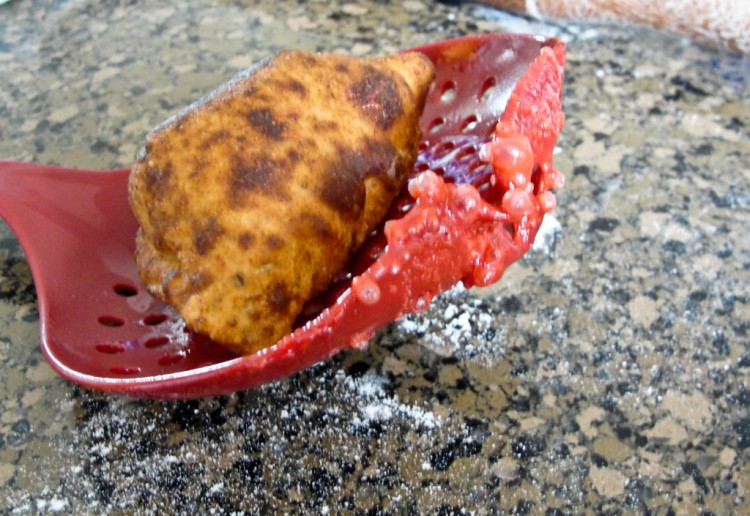If you enjoy Indian food on a regular (or even semi-regular) basis, you have probably heard of the samosa. The samosa is to India what the “Hot Pocket” is to America…only it has a million times more flavor. And no cheese. And includes vegetables. Okay, it’s nothing like a Hot Pocket. It’s better! Way better.
Typically samosas are made with a combination of potatoes, peas and spices. This stellar combination makes a pretty dry curry that is then stuffed into a cone-shaped piece of pastry, and formed into triangles. The triangles are then fried and enjoyed with different chutneys or ketchups. Even people that “don’t like Indian food” like samosas!
In Kolkata (and the majority of West Bengal) samosas are called singaras. They use different spices

and usually include cauliflower, fried peanuts, and sometimes even a little coconut. They are so tasty that I would officially proclaim them to be the king of all samosas! Unfortunately I can’t get them here, and had no idea how to make them.
While we were visiting I requested singaras most days, and either Baba would pick them up on his way home from the office or Piyush and I would take a little walk to one of the sweet shops and buy some kalakand and fresh fried singaras. We’d enjoy them before dinner, as a snack, while drinking tea and watching “Big Boss” (India’s version of Big Brother). After craving them for months, and hearing my father-in-law talk about them every time we call India (I think he’s teasing me!), I finally I decided it was time to demystify the singara and figure out how to make it at home.
Because singaras are typically bought roadside instead of made at home, learning to make them while I was in India didn’t really cross my mind. They are so cheap—less than 6 cents (American) a piece, that people just don’t bother making them.

On our next trip, I am going to try and befriend a shopkeeper and see if they’ll teach me the trick to making the perfect singara. Until that time comes, I’ll have to settle for my homemade version—which is pretty dang good, don’t get me wrong—it’s just not the same.

My version of the Singara (a.k.a. the next best thing):
Dough:
- 1 c. all purpose flour
- 1/2 c. whole wheat flour
- 1/2 tsp. ajwain seeds
- 1 tbsp. oil
- salt, to taste
- water, enough to make a soft dough
Filling:
- 1 large potato- peeled, cubed, and boiled
- 1/2 cup (or so) of frozen peas
- 1/2 c. cauliflower florets- cut very small
- 2 tsp. ginger paste (or preferably fresh ginger)
- 2 tbsp. peanuts- cut in pieces
- 1 tbsp. coconut, diced fine
- 1 tsp. sugar
- 1 tsp. ground cumin
- 1 tsp. pachpuran (Bengali five-spice mix)
- 1 tsp. garam masala
- 1 tsp. amchoor powder (dried mango powder)
- 1 tsp. turmeric powder
- 1/2 tsp. hing
- 3 green chiles, or to your taste- diced finely
- cilantro, to your taste
- salt, to taste
- oil, for frying
Directions:
- Make the dough by mixing all the dry ingredients in a bowl and adding enough water to form a soft dough. The dough should be a little sticky, but not too sticky. It’s really hard to describe how a dough should be over the internet. I think it’s something you need to have the feel of. Once you’re happy with the texture of your dough, cover it with a damp cloth and set it aside.
- Start making the filling. Add a little oil to a pan and fry the potatoes until they start browning. Remove them from the pan and then add a little extra oil. Fry the peanuts and the coconut. Once they turn brown, remove them from the pan and drain them on a paper towel.
- Using the same oil as you fried the peanuts and coconut in, cook the chile, ginger and spices for about a minute (or until everything becomes fragrant). Add the peas and cauliflower. Fry for about 3 minutes. Then add the potatoes, cilantro, peanuts and coconut into the pan. Cook this (adding a little water, if necessary) until the vegetables are tender. Salt, to taste. Set this aside and let it cool.
- Separate the dough into 8 balls. Roll out each ball, one at a time. Once it is rolled out, cut it in half.
- Brush the edges with a little water and form a cone with one of the halves, using your fingers. Press the dough together lightly where it meets on the edges. Fill the cone with the potato/cauliflower filling and then seal the singara by brushing a little water on one edge and pressing the whole thing together.
- Fry the singaras in oil over medium heat until they are golden brown and delicious.
- Serve with chutneys or ketchup…and wash it down with a warm cup of tea or a cold Thums Up

P. S. Don’t use a plastic spoon in hot oil.

P.P.S. Thank you to Summer for teaching me how to deep fry. I suck at frying. Now, I suck a little less! 😀








Oh, those look so amazing. Well, except for that poor plastic spoon. 🙂 I’ve never heard of pachpuran, amchoor and hing though. I’ll need to do some research. Thank you for sharing the recipe.
I should do a post on Indian spices. Maybe tomorrow!
Yumm chef anjum anand has a great baked potato and pees samboosa recipe with similar spices you gotta try out it’s my favourite I stock a bunch in the freezer. Life savers! Ur recipe sounds yumm can’t wait to try,
I think I’ve tried hers, were they made with phyllo dough?
yeah exactly ! im about to go try your recipie now the addition of grated coconut sounds Genius lol!
Mmm, these look fantastic 🙂 I adore Indian cuisine, and how lovely that they are vegan, too!
It reminds me it is time to make samosas again! These look yummy as well.
It was fun to hang out with you and make some amazing food even if we did melt a spoon!!
I agree!!! We should do it more often! Did Eric and Isabelle like the Momos?
They sure did!!! Eric said I have to learn how to make them and Isabelle was real nonchalant but was the first one done eating. Then she insisted that I give her the rest of mine because they were “pretty good.” She is so silly.
[…] already blogged about the singaras (here) and the aloo tikkis (here); but today I want to introduce you to the […]
They look lovely! Being a die-hard singara fan myself, I’m surprised I never thought about making one at home; I’ll definitely try your recipe soon!
🙂
I still haven’t quite perfected the singara, but this recipe is pretty good! In my opinion, any singara is better than no singara! Enjoy!
I confess …I. Initially wanted to follow your blog..because you married an Indian and we indians so so so love angreji Bahus ……but then I tried your singra yesterday ,,,and now I follow u only for u and your recipes …
Your recipes rock
Am trying the dabeli tomorrow for holi
Happy holi
I’m glad you enjoyed the singhara! I hope you enjoy the dabeli as well…it’s one of my favorites!